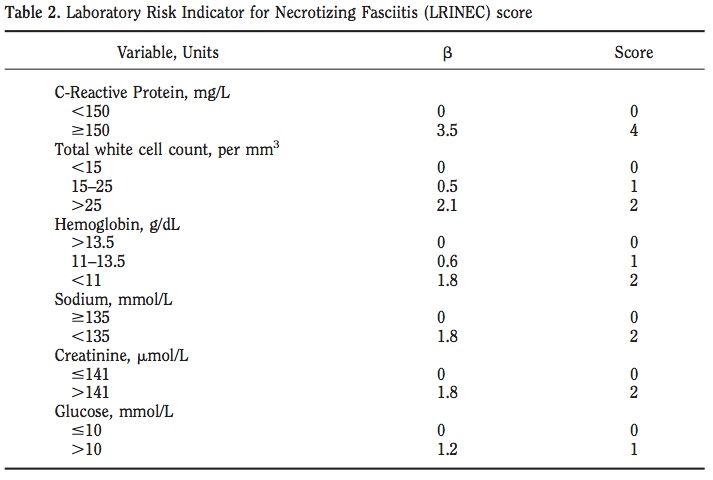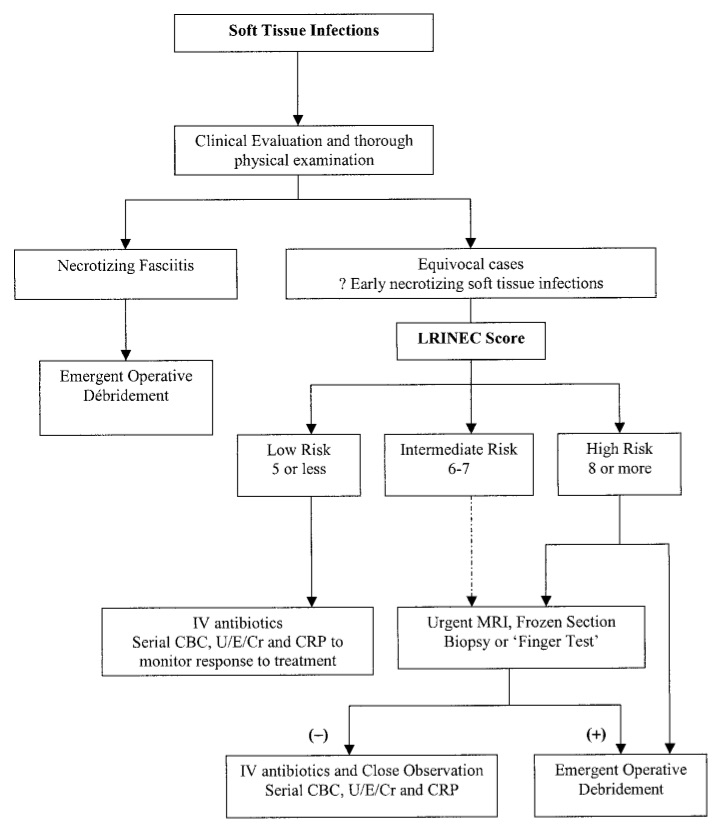Article Citation:
Wong CH, Khin LW, Heng KS, Tan KC, Low CO. The LRINEC (Laboratory Risk Indicator for Necrotizing Fasciitis) score: a tool for distinguishing necrotizing fasciitis from other soft tissue infections. Crit Care Med. 2004 Jul;32(7):1535-41. PMID: 15241098
Resident Reviewer: Courtney Cassella
What we already know about the topic
Necrotizing fasciitis is a severe soft tissue infection with high mortality. Early recognition and aggressive debridement improves prognosis. Clinical judgement can be augmented with CT, MRI, and/or biopsy to diagnose necrotizing fasciitis.
Why this study is important
Given the high mortality of necrotizing fasciitis and difficulty in diagnosis, additional factors for early recognition are essential. This study aimed to identify easily accessible predictors of necrotizing fasciitis to support clinical decision-making.
Brief overview of the study
This was a retrospective observational study of patients first in a developmental (n=314) then validation (n=140) cohort. The study compared necrotizing fasciitis patients versus control patients with severe soft tissue infection of cellulitis or abscess. Thirteen variables were analyzed and the score was constructed by univariate and multivariate logistic regression analyses. The final model is composed of 6 variables: WBC, CRP, Hgb, Na, glucose, and Cr. The LRINEC score stratified patients into three groups low (≤5), moderate (6-7), or high (≥8) risk for necrotizing fasciitis. Risk corresponded to <50%, 50-75%, and >75% probability of developing soft tissue infection. A score of ≥6 points had a positive predictive value of 92% and negative predictive value of 96%. A score of ≥ 8 points is strongly predictive (PPV 93.4%).
Limitations
The score is first limited by its derivation from a retrospective cohort thus emphasizing the need for prospective validation. The study was performed in Singapore, which can lead to some question about generalizability in our population. The score is meant to detect early necrotizing fasciitis and may be used as a serial assessment especially in the setting of worsening labs despite antibiotics, however interventions such as intravenous fluids, insulin, and transfusions can interfere. Lastly, although the score is supposed to be composed of common laboratory values the inclusion and weight of elevated CRP may not be as commonly obtained in the emergency department.
Take home points
- LRINEC score can be an adjunct to risk stratify patient with soft tissue infections
- Serial assessments may help find early infection
- Patients with LRINEC ≥ 6 points are intermediate risk for necrotizing fasciitis
- A low LRINEC score does not exclude necrotizing fasciitis!


